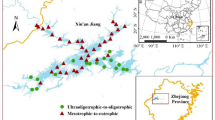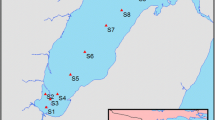Abstract
All pixels in satellite data are essentially mixture pixels that composed of many sub-pixels with different bio-optical properties due to the continuum of variation of water dynamic conditions and the intrinsic mixed nature of water body. Generally, it is more possible to successfully find the “clear water” from data with high spatial resolution than these with low spatial resolution, because the mixed pixel in low spatial resolution data is more complicated and mixing than these in high spatial resolution data. To account for this, an improved cross-platform atmospheric correction model (ICAC) has been developed for removing the atmospheric effects from the Landsat-5 image. The accuracy and stable of ICAC model is evaluated through comparison between the satellite-derived and synchronized field-measured remote sensing reflectance. The results indicate that use of ICAC model can produce 7.19, 8.76, 5.28, and 14.42 % uncertainty in deriving remote sensing reflectance at three visible and one near-infrared bans, respectively, from Landsat-5 data. By comparison, using the ICAC algorithm in removing atmospheric influence on Landat-5 data in Taihu Lake could decrease by 6.32, 12.80, 25.45, and 32.96 %, respectively, at three visible bands and one NIR band to traditional cross-platform atmospheric correction algorithm. The improvements are very significant.





Similar content being viewed by others
References
Bailey, S. W., & Werdell, P. J. (2006). A multi-sensor approach for the on-orbit validation of ocean color satellite data products. Remote Sensing of Environment, 102, 12–23.
Chen, J., Fu, J., & Zhang, M. W. (2011). An atmospheric correction algorithm for landsat/TM imagery basing on inverse distance spatial interpolation algorithm: a case study in Taihu Lake. Journal of Selected Applied Earth Observation and Remote Sensing, 4(4), 882–889.
Chen, J., Wang, B. J., & Gao, X. J. (2012). Scale corection of two-band ratio of red to near-infrared using imagery histogram approach: a case study on Indian remote sensing satellite in Yellow River estuary. IEEE Journal of Selected Topic on Applied Earth Observation and Remote Sensing, 5(2), 663–668.
Chen, J., Quan, W., Wen, Z., & Cui, T. (2013). A simple “clear water” atmospheric correction algorithm for Landsat-5 sensors. I: a spectral slope based method. International Journal of Remote Sensing, 34(11), 3787–3802.
Chen, J., Cui, T. W., & Lin, C. S. (2014). An improved SWIR atmospheric correction model: a direction-based model. IEEE Transactions on Geoscience and Remote Sensing, 52(7), 3959–3967.
Clavano, W. R., Boss, E., & Lee, K. B. (2007). Inherent optical properties of non-spherical marine-like particles——from theory to observation. Oceanography and Marine Biology, 45, 1–38.
Gordon, H. R., & Castano, D. J. (1989). Aerosol analysis with the coastal zone color scanner: a simple method for including multiple scattering effects. Applied Optics, 28(7), 1320–1326.
Gordon, H. R., & Clark, D. K. (1980). Remote sensing optical properties of a stratified ocean: an improved interpretation. Applied Optics, 19, 598–600.
Gordon, H. R., & Clark, D. K. (1981). Clear water radiance for atmospheric correction of coastal zone color scanner imagery. Applied Optics, 20(24), 4175–4180.
Gordon, H. R., & Franz, B. A. (2008). Remote sensing fo ocean color: assessment of the water-leaving radiance bidirectional effects on the atmospheric diffuse transmittance for SeaWiFS and MODIS intercomparisons. Remote Sensing Environment, 112, 2667–2685.
Gordon, H.R., & Voss, K.J. (1999). MODIS normalized water-leaving radiance algorithm theoretical basis document. NASA Technical Report Series, NAS5-31363.
Gordon, H. R., & Wang, M. H. (1994). Retrieval of water-leaving radiance and aerosol optical thickness over the oceans with SeaWiFS: a preliminary algorithm. Applied Optics, 33(3), 443–452.
Gordon, H. R., Brown, J. W., & Evans, R. H. (1988). Exact Rayleigh scattering calculations for use with the Nimbus-7 coastal zone color scanner. Applied Optics, 27(5), 862–871.
Gordon, H.R., Du, T., & Zhang, T. (1997). Remote sensing of ocean color and aerosol properties: resolving the issue of aerosol absorption. Applied Optics, 36
Hale, G. M., & Querry, M. R. (1973). Optical constants of water in the 200 nm to 200 micrometer meter wavelength region. Applied Optics, 12(3), 555–563.
Hu, C. M., & Carder, K. L. (2002). Atmospheric correction for airborne sensors: comment on a scheme used for CASI. Remote Sensing of Environment, 79, 134–137.
Hu, C. M., Muller-Karger, F. E., Andrefouet, S., & Carder, K. L. (2001). Atmospheric correction and cross-calibration of Landsat-7/ETM+ imagery over aquatic environments: a multiplantform approach using SeaWiFS/MODIS. Remote Sensing Environment, 78, 99–107.
Jiménez-Muñoz, J. C., Sobrino, J. A., Mattar, C., & Franch, B. (2010). Atmospheric correction of optical imagery from MODIS and reanalysis atmospheric products. Remote Sensing of Environment, 114, 2195–2210.
Kuchinke, C. P., Gordon, H. R., & Franz, B. A. (2009). Spectral optimization for constituent retrieval in case 2 waters I: implementation and performance. Remote Sensing of Environment, 113, 571–587.
Lavender, S. L., Pinkerton, M. H., Moore, G. F., Aiken, J., & Blondeau-Patissier, D. (2005). Modification to the atmospheric correction of SeaWiFS ocean colour images over turbid waters. Continental Shelf Research, 25, 539–555.
Liang, S. L., Fang, H. L., Morisette, J. T., Chen, M. Z., Shuey, C. J., Walthall, C. L., & Daughtry, C. S. T. (2002). Atmospheric correction of landsat ETM+ land surface imagery: II. Validation and applications. IEEE Transactions on Geoscience and Remote Sensing, 40, 1–10.
Mao, Z., Chen, J., Pan, D., Tao, B., & Zhu, Q. (2012). A regional remote sensing algorithm for total suspended matter in the East China Sea. Remote Sensing of Environment, 124, 819–831.
Markham, B. L., & Helder, D. L. (2012). Forty-year calibrated record of earth-reflected radiance from landsat: a review keywords: landsat, radiometric calibration, history. MSS, TM, ETM+. Remote Sensing of Environment. doi:10.1016/j.rse.2011.1006.1026.
Mobley, C. D. (1994). Light and Water: radiative transfer in natural waters. New York: Academic.
Mueller, J.L., & Fargion, G.S. (2004). Ocean optics protocols for satellite ocean color sensor validation. Revision 5 Part II, 171–179.
Ouaidrari, H., & Vermote, E. F. (1999). Operational atmospheric correction of landsat TM data. Remote Sensing of Environment, 70, 4–15.
Shi, W., & Wang, M. (2009). An assessment of the black ocean pixel assumption for MODIS SWIR bands. Remote Sensing of Environment, 113, 1587–1597.
Wang, M., & Gordon, H. R. (1994). A simple moderate accuracy atmospheric correction algorithm for SeaWiFS. Remote Sensing of Environment, 50(3), 231–239.
Wang, M. H., Tang, J. W., & Shi, W. (2007). MODIS derived ocean color products along China east coastal region. Geophysical Research Letters, 34, 1–5.
Wang, M. H., Son, S. H., & Shi, W. (2009). Evaluation of MODIS SWIR and NIR-SWIR atmospheric correction algorithms using SeaBASS data. Remote Sensing of Environment, 113, 635–644.
Wang, M., Shi, W., & Tang, J. (2011). Water property monitoring and assessment for China’s inland Lake Taihu from MODIS-Aqua measurements. Remote Sensing of Environment, 115, 841–854.
Werdell, P. J., Franz, B. A., & Bailey, S. W. (2010). Evaluation of shortwave infrared atmospheric correction for ocean color remote sensing of Chesapeake Bay. Remote Sensing of Environment, 114, 2238–2247.
Xu, Q. J., Qin, B. Q., Chen, W. M., & Gao, G. (2001). Ecological simulation of algae growth in Taihu Lake. Journal of Lakes Science, 13(2), 149–157.
Yang, D. T., Pan, D. L., Zhang, X. Y., Zhang, X. F., He, X. Q., & Li, S. J. (2006). Retrieval of chlorophyll a and suspended solid concentrations by hyperspectral remote sensing in Taihu Lake, China. Chinese Journal of Oceanology and Limnology, 24(4), 428–434.
Acknowledgments
We would also like to express our gratitude to three anonymous reviewers for their useful comments and suggestions.
Author information
Authors and Affiliations
Corresponding author
About this article
Cite this article
Yi, C. An Improved Cross-Platform Atmospheric Correction Approach for Landsat-5 Sensor in Turbid Waters using MODIS Sensor. J Indian Soc Remote Sens 44, 233–242 (2016). https://doi.org/10.1007/s12524-015-0497-6
Received:
Accepted:
Published:
Issue Date:
DOI: https://doi.org/10.1007/s12524-015-0497-6




